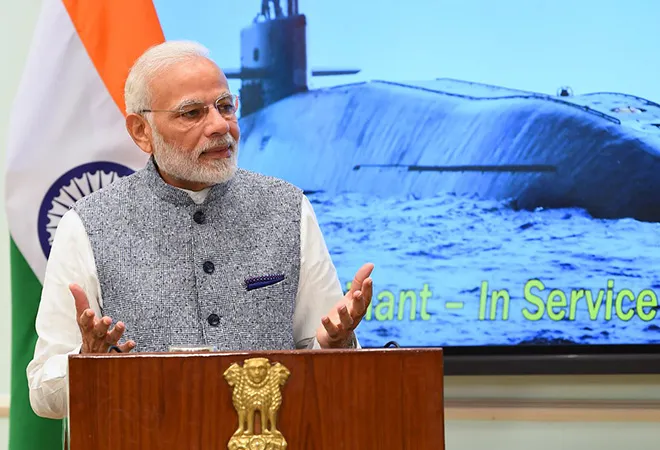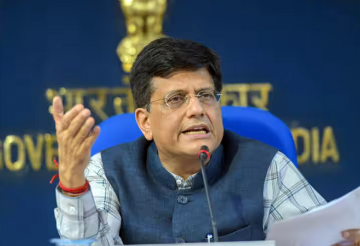
In the time of elections, perhaps, it should not be surprising that achievements end up getting somewhat hyped up beyond their actual significance. That’s what seems to have happened with the first “deterrence patrol” of the INS Arihant being welcomed by Prime Minister Narendra Modi in an effusive press release on Monday.
Issued by the Prime Minister’s Office the release referred to the PM in six of the seven paragraphs of its note. It also mis-characterised India’s first nuclear propelled ballistic missile submarine or SSBN as a ‘Strategic Strike Nuclear Submarine’ whereas the conventional meaning of the acronym SSBN is ‘Ship Submersible Ballistic Nuclear Submarine.’ The project to build such a submarine termed the Advanced Technology Vessel (ATV) at the Ship Building Centre, Vishakapatnam, has been on since the mid-1980s.
We will not go into the paens the press release raised while mentioning the Prime Minister in six of its seven paragraphs, but analyse the development itself. The PM was clearly in election mode when he spoke/tweeted of the event, but it is unusual for an Indian leader to hype up, as the PM clearly did, an issue relating to our nuclear deterrent. In a tweet, Modi
conflated the event with the celebration of Dhanteras. The note cited him saying that “just as light dispels darkness and all fear, INS Arihant will be harbinger of fearlessness for the country.” He declared that the successful deployment of the SSBN had completed “the establishment of the country’s survivable nuclear triad.” This is a somewhat misleading exaggeration.
As of now the lone SSBN, the Arihant fields the K-15 ballistic missile with a limited range of just 750 kms. This would ensure that it can, at some risk to its own safety, target Sind (Karachi)and Balochistan (Gwadar). The limited range of the missiles would require the SSBN to come close to the Pakistani mainland where it can be targeted by Pakistani SSKs.
The rest of Pakistan and all of China would be off-limits. It will be only after India develops the more advanced versions of the K-series missiles over the coming decade that the SSBNs will come into their own as the key leg of India’s nuclear deterrent. In any case, a viable triad only comes into being when India has an SSBN on patrol all the time.
Monday’s report is somewhat confusing for another reason. A report on October 2016 had spoken of the INS Arihant as
having been commissioned in a secret ceremony by the Navy chief.
If so, a deterrent patrol being done two years later is somewhat strange.
Other reports, however, said that it was only this July that the Arihant completed its sea trials, that included deep diving and weapons firing. The report cited the Eastern Naval Command chief to say that “The submarine will be commissioned after completing all the sea trials.”
So, if as the PMO press release says that it completed its first deterrence patrol, it is a welcome development, though it is surprising that no formal commissioning ceremony was held for the Arihant.
The fabrication of the submarine (with considerable Russian help) is indeed an achievement that puts India in a limited group of people with such vessels. But let us be clear India will be able to have an truly usable undersea leg of its nuclear deterrent capability when it can field missiles that have a range of 3,500 to 6,000 kms plus. Such missiles will come over the coming decade and they would also require submarines that are bigger. Both projects are being undertaken by the Navy-DRDO setup, but they are far from actually operationalising them at this juncture.
SSBN’s are not built for speed, but stealth. Their role is to guarantee the country with a nuclear strike capability when all other means fail. At present it is universally acknowledged that missile-carrying submarines are the hardest to detect and are therefore the best means of safeguarding a country’s nuclear deterrent. Ideally what India will seek are vessels which can operate in protected waters in the Bay of Bengal or the Arabian Sea, and yet be capable of targeting distant cities in China or Pakistan.
Not surprisingly, in September 2013, when the Agni V was launched it was greeted by similar breathless reporting as India’s first missile that could reach Chinese cities. That was, mind you, a good five years before the missile’s problems were ironed out and further tests conducted. It was only this year that the missile is actually slated to be inducted into the arsenal.
In many of the areas relating to missiles and submarines, we remain behind China and Pakistan, with the help of China continues to nip at our heels. Indeed, all analysts say that in terms of the numbers of nuclear weapons, Pakistan remains ahead of India.
The idea of building a nuclear propelled submarine goes back to the late 1970s. Soon thereafter it became clear to us that notwithstanding our tendency to hype our capabilities, we were not all that advanced in areas like engineering, metallurgy or even nuclear science. The first project led by the Department of Atomic Energy ran aground in the early 1980s. So, a more practical approach was taken for the second. On one hand, India leased a Soviet Charlie II submarine, and also initiated a project to design one to drawings and “consultancy” provided by the Russians. A variety of reasons made progress painfully slow.
By 1990, the SBC had been set up in Vizag, along with a covered dry dock, a steam turbine test facility, a radiation safety services wing, and a workshop. But going was tough, these were the times of crisis in both India and Russia. The other problem was that India’s efforts to make a 100 MW reactor to power the submarine were not going anywhere. In the end, the Russians had to help. Begun in an era when India was not a declared nuclear power, the submarine was based on the Charlie II or Skat submarine which is optimised for using cruise missiles. However, after the 1998 nuclear tests, India wanted a boat which could fire ballistic missiles. As a result there were some changes in design which led to the builders having to give it a ballast of 500 tonnes to balance it.
The reactor was copied from a Russian design and has a 83 MW output.
Last November, the second of the Arihant class, named the Arighat was launched in a quiet ceremony by Defence Minister Nirmala Sitharaman. But it will take another three years before the vessel is formally commissioned. Beyond this two more units of a larger size are in the process of being built. These will be able to house the larger long-ranged missiles, but it would require a new and more powerful reactor. India also needs such reactors for a new class of attack submarines SSNs, that it is planning to build.
An interesting and important aspect of the press release was the reiteration of India’s “no first use” posture and its policy of maintaining a “credible minimum deterrence.” In the past decade there have been several suggestions and statements indicating that New Delhi may like to revisit these two issues in view of the Pakistani theatre nuclear weapons and the Chinese nuclear force modernisation. Clearly, as of now, though India says it is sticking to the principles of the doctrine it enunciated in a press release of 4 January 2003 summarising the decisions of the Cabinet Committee of Security on that date.
This is important because in its 2014 the BJP election manifesto had spoken of the possibility of revising this doctrine. However, subsequently they had backed off and reiterated the Vajpayee-era formulation. But, in October 2014, speaking at the Munich Security Conference, the National Security Advisor Ajit Doval had declared that India was “shifting its posture from credible minimum deterrence to credible deterrence.” Clearly, as of now this change has not been effected. Doval, it should be noted, heads the executive council of India’s nuclear command authority, whose political council is headed by the Prime Minister himself.
The Monday press release on the Arihant’s first deterrent patrol also raises another question: Just how will the government maintain political control over the nuclear weapons when they are out deep in the sea where communications are through an extra-low frequency system. More important, there is a phase in their operations when they cut off all communications for their own security. So, an element of pre-delegation of authority for launch must be built in.
On land, so far, India has maintained control by keeping the nuclear core and the weapons under the separate control of the DRDO and the Department of Atomic Energy. But in a deterrent patrol, the SSBN must go with ready-to-use weapons. In countries like the US who do not subscribe to the “no first use” idea and keep ready-to-use weapon, control is exercised principally through a two man rule. In US SSBNs while two separate set of personnel must authorise launch, they in turn can get their keys by unlocking separate safes through combinations that will arrive with the launch order from the appropriate authority.
Notwithstanding all this, or the most recent Prime Ministerial exuberance, the Indian approach to nuclear weapons remains sensible and low key. Nuclear weapons are not things you flaunt and wave about. So, the emphasis in incremental steps to enhance our deterrent capabilities remains because we have some way to go before we can say we have a survivable triad that can retaliate under all circumstances. The present status of INS Arihant is a welcome development, but we must not exaggerate it needlessly and allow nuclear weapons to become part of the election cycle.
Prime Minister felicitates crew of INS Arihant on completion of nuclear triad
Dinakar Peri, “
Now, India has a nuclear triad,”
The Hindu, October 18, 2016.
“
INS Arihant undergoing sea acceptance trials: Top official,”
The Economic Times, 14 July 2018.
Manoj Joshi “Desperately copying Charlie: India designs nuclear submarine,”
The Times of India, 14 December 1994
Manoj Joshi, “
Indian boomer: The launch of the Arihant,”
Mail Today, 26 July 2009.
Sandeep Unnithan, “
A peek into India’s top secret and costliest defence project, nuclear submarines,”
India Today 10 December 2017.
The views expressed above belong to the author(s). ORF research and analyses now available on Telegram! Click here to access our curated content — blogs, longforms and interviews.



 In the time of elections, perhaps, it should not be surprising that achievements end up getting somewhat hyped up beyond their actual significance. That’s what seems to have happened with the first “deterrence patrol” of the INS Arihant being welcomed by Prime Minister Narendra Modi in an effusive press release on Monday.
In the time of elections, perhaps, it should not be surprising that achievements end up getting somewhat hyped up beyond their actual significance. That’s what seems to have happened with the first “deterrence patrol” of the INS Arihant being welcomed by Prime Minister Narendra Modi in an effusive press release on Monday.  PREV
PREV


